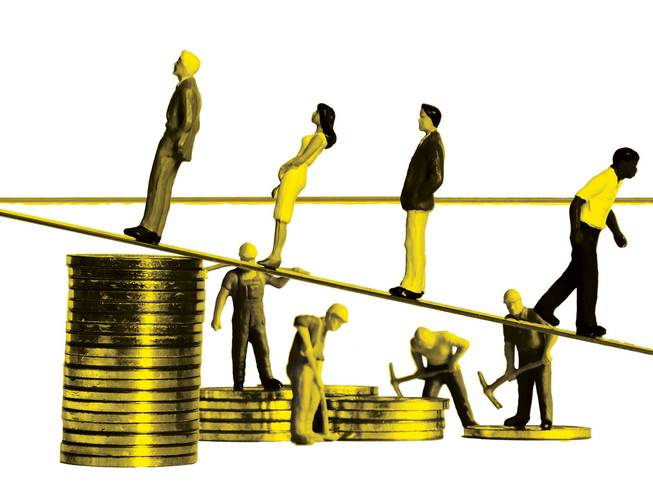
Shutterstock.com
Friday, Jan. 17, 2020 | 2 a.m.
Unemployment is low. The housing market has bounced back. But since the Great Recession devastated Nevada’s economy more than 10 years ago, one thing hasn’t changed: wages for the average Nevadan.
Mean annual pay in Nevada stood at $42,984 in 2008, according to data from the Bureau of Labor Statistics. In 2018, it had climbed to just $50,041. Adjusted for inflation, that’s a 1.9% decrease in salary for the average worker in the state during that time frame.
While average wages have risen slightly nationwide over the past decade, just two other states—Connecticut and Wyoming—saw inflation-adjusted wages similarly decrease between 2008 and 2018, BLS data shows. All other states experienced an inflation-adjusted pay boost, ranging from very modest to substantial, for the average worker.
Experts and advocates offer a number of possible explanations for why wages in Nevada haven’t kept up with inflation: the nature of the dominant gaming and tourism industry, pro-business state policies that some claim deprioritize workers, the lingering effects of the Great Recession and more. But, especially given the looming potential for another recession, there’s a larger and more complicated question: What could be done to elevate the state’s stagnant wages?
Meredith Levine, director of economic policy at the Nevada-based Guinn Center for Policy Priorities, hypothesizes that the high prevalence of service sector jobs in Nevada has held back wage growth to an extent.
According to a 2019 Guinn Center report on post-Great Recession economic trends in Nevada, gaming, tourism, accommodations and food services account for nearly half of all jobs in the state. Workers in these industries are more likely to earn hourly wages at or close to the minimum wage than workers in any other industry, according to Levine.
“Wages in these sectors tend to remain flat, and the concentration in Nevada likely depresses wages relative to other states in the nation,” she said.
Even though 13.9% of workers in the state—many in the relatively low-wage service sector—belonged to unions as of 2018, Laura Martin, executive director of Progressive Leadership Alliance of Nevada, described the state as more pro-business than pro-worker. Nevada’s is considered one of the fastest-growing state economies, but that growth hasn’t necessarily translated into benefits for workers, Martin said.
“I really think we have to examine the way we do politics, the way we govern and what we’ve convinced ourselves is the way forward,” she said.
Lawmakers appear to be doing that to some extent as of late. On July 1, the minimum wage in Nevada will increase above the federal minimum wage, which itself hasn’t gone up since 2009.
Under a bill passed during the 2019 legislative session, employers will be required to pay workers at least $8 per hour if they’re also offering them health care or at least $9 per hour if they don’t. The minimum wage will continue to rise incrementally for the next four years until it reaches $11 per hour for workers with health care and $12 per hour for workers without it.
That will bring Nevada to the “middle of the pack” compared with other states, said David Cooper, a senior economic analyst at the nonprofit, liberal-leaning Economic Policy Institute. Nonetheless, the increase will help only those at the bottom of the economic spectrum, even though the slowest wage growth in the country has been observed among the middle class, he said.
Middle-class Nevadans are likely still feeling the impacts of the 2007-09 Great Recession when it comes to their wages, according to Cooper. Nevada was arguably hit harder than any other state by the burst of the U.S. housing bubble leading up to the recession, resulting in soaring unemployment. It had the highest unemployment rate of any state for 50 months between January 1, 2009, and December 1, 2018, according to Cooper.
Those lucky enough to keep their jobs were probably unlikely to get raises during that time.
“Whenever employers see that there’s a line of people wrapped around the block for every job opening, there’s no incentive for them to raise wages,” Cooper said.
While the Nevada unemployment rate has decreased to about 4.1% from its recession peak of 13.7%, the jobs that returned to the state might not pay as well as the ones that left. One good example: the construction industry. As of November 2019, Nevada had 22,000 fewer construction jobs—which tend to be relatively high-paying and accessible—than it did in December 2007, Cooper said.
Given that the Great Recession and resulting layoffs could have contributed to the state’s stagnant wages, another recession could have a similar effect on the workforce, dropping wages further relative to inflation, Cooper said. To prevent that, state and local leaders could adopt some new policies before another recession hits.
Geoconda Arguello-Kline, secretary-treasurer of the Culinary Union, said that state leaders could better support unions, which lift wages for all workers, unionized or not. Most of the service industry workers employed by non-union hotel-casinos—properties owned by Station Casinos and the Las Vegas Sands Company—are making well above minimum wage because those employers have to compete with unionized jobs on the Strip, she said. (She pointed out that unionized jobs deliver other benefits, though, such as job security.)
In addition to supporting unions, Nevada could adopt policy tools that have proven successful in other states, like expanding eligibility for overtime pay so that more workers are compensated for extra hours, Cooper said. The state could also outlaw or better regulate noncompete agreements imposed on workers, which reduce pressure to raise wages. And local leaders could pledge to contract with companies that pay a living wage, according to Cooper.
“State lawmakers don’t need to wait for federal action on some of these other things,” he said.
Nonetheless, Levine says that additional research is needed to better understand and find ways to lift Nevada’s flat wages. The Guinn Center plans to investigate the issue in more depth later this year.
This story appeared in Las Vegas Weekly.
